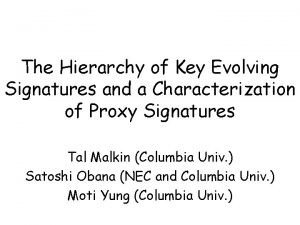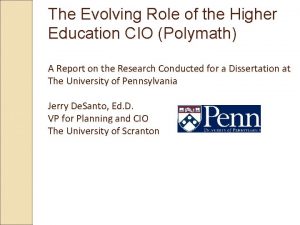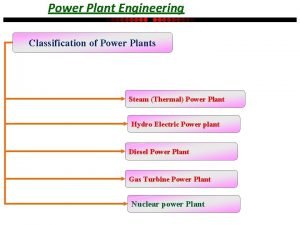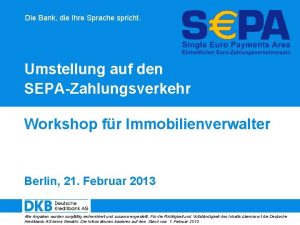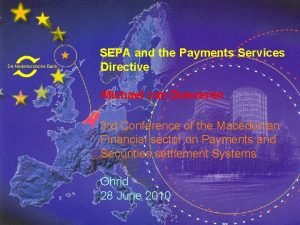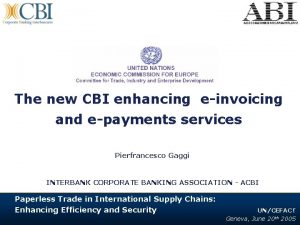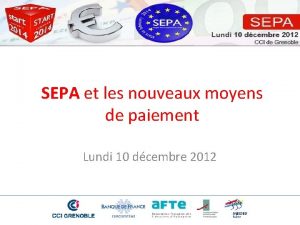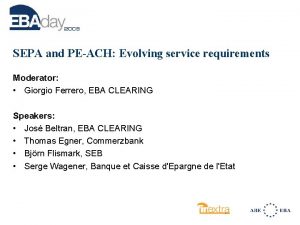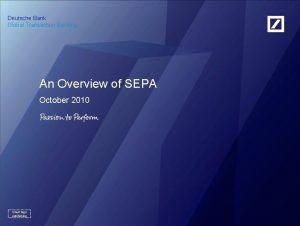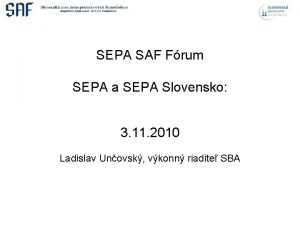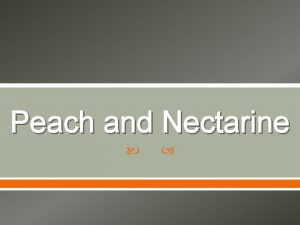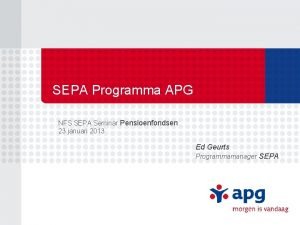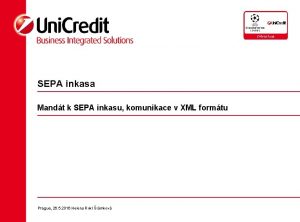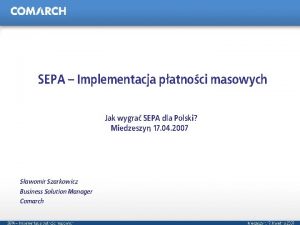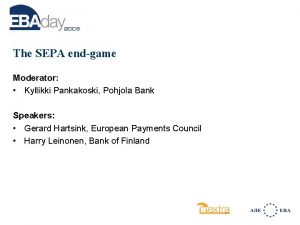SEPA and PEACH Evolving service requirements Moderator Giorgio













- Slides: 13

SEPA and PE-ACH: Evolving service requirements Moderator: • Giorgio Ferrero, EBA CLEARING Speakers: • José Beltran, EBA CLEARING • Thomas Egner, Commerzbank • Björn Flismark, SEB • Serge Wagener, Banque et Caisse d'Epargne de l'Etat

The evolution of EBA CLEARING’s SEPA Services José M Beltrán, Director STEP 2 Services, EBA CLEARING

STEP 2 SCT Ramp-up • • STEP 2 SCT currently processes 185, 000 payments a day - 54% migrated from STEP 2 XCT - 46% new SEPA payments STEP 2 SCT SEPA domestic • 23% of SCT payments are within the same country STEP 2 SCT is SEPA domestic to: - Luxembourg, Finland major Italian Banks - A number of other countries

STEP 2 SCT: Participants (NL) 111 EQUENS Direct Participants 4, 341 Indirect Participants 95% of FIs having adhered PBS to STEP 2: SEPA HUB the EPC SCT Scheme 14 Technical Facilitators VOCALINK in 12 Countries SIA SSB SECETI SIBS IBERPAY KIR SCC EQUENS (DE) STEP. AT Euro SIC BANKA SLOVENIJE DIAS

Recent and ongoing developments • Launch of STEP 2 SCT Service on 28 th January 2008 – Payments Ahead of Value Date (Warehousing), STP Returns, – ISO 20022 XML messaging • Implementation of M-PEDD Phase 1: – STEP 2 SDD Service: Ready to use–in Test & Training • Introduction of a Same Day Processing Cycle on 5 th May 2008 SEEBACH – Development of Multilateral Netting Module (MNM) • Settlement of STEP 2 SCT Service in TARGET 2: on 8 th December 2008 – Multilateral Net Balances – Two Settlement cycles on D – 07: 30 & 14: 00 – Supporting Settlement of Bilateral Clearing • Introduction of a Night-Time Settlement Window for STEP 2 SCT – Settlement on D at 01: 30 CET

SEPA and PE-ACH The Luxembourg migration Serge Wagener, Banque et Caisse d’Epargne de l’ Etat, Luxembourg

The Luxembourg SEPA migration (1) • September 2002 – Introduction of IBAN for domestic usage • July 2003 – BCEE is first bank in Luxembourg to participate in STEP 2 XCT, and offering Entry Point services • Reachability is assured • October 2005 – IBAN becomes mandatory for domestic credit transfers • all domestic transfers are SEPA-compliant – Decision taken to migrate domestic payments to STEP 2 XCT

The Luxembourg SEPA migration (2) • October 2006 – Shut down of local ACH, Lips. Net • January – February 2008 – Technical migration from STEP 2 XCT to SCT • Today: • 67% of incoming payments via SCT • 82% of outgoing payments via SCT • Returns • Reachability

The Luxembourg SEPA migration (3) The best choice in 2006: does it remain a good choice in the medium and long term? • 2010 deadline challenged by a number of banking communities • The discussion is on-going • Commitment from other banking communities to move to a pan. European infrastructure? • Trend is positive • Uncertainty about how the future European infrastructure for retail payments will develop • The landscape is changing • Uncertainty about future costs • The business case is positive, for credit transfers

SEPA and PE-ACH Evolving service requirements Thomas Egner, Commerzbank

Evolving service requirements – where do we come from? • • • XCT as a pre-SEPA service Successful provisioning and start of the new SEPA SCT Service (SDD to follow), i. e. : – Implementation of core payment scheme – Implementation of defined processes – In time, in money – Significant REACH provided to the users – Providing service for all market parties, i. e. Financial Institutions (DP and IP) plus CSMs – Attractive pricing policy (Re-)Use of already existing technology – Robust and reliant system – Separate product/scheme/service on existing platform – Use of well-functioning clearing and settlement service

Evolving service requirements – where should we go? • Chase for volume, i. e. national transactions, new business fields, e. g. opening the platform for other services/schemes such as cards • Building components around existing schemes, resulting in a better service without changing schemes, i. e. more settlement cycles • Low profile service vs. full service offering with an individual choosable service structure (by flexible bundling) • Overall attractive pricing offering • Support of nationally/user group defined AOS

Future developments • STEP 2 SCT Service enhancements – EPC Rule Book changes v 3. 2 & User enhancements – 2 nd February 2009 • STEP 2 SDD Service enhancements – EPC Rule Book changes v 3. 1 & User enhancements – 2 nd November 2009 • M-PEDD phase 2 – Implementation & launch of a STEP 2 B 2 B Debit Service – 2 nd November 2009 – Evolution of STEP 2 Interactice Workstation Services • Risk mitigation, e-mandates, • Development of file-based service for other euro payments • Multi-currency processing service • Card Settlement • E-invoicing


